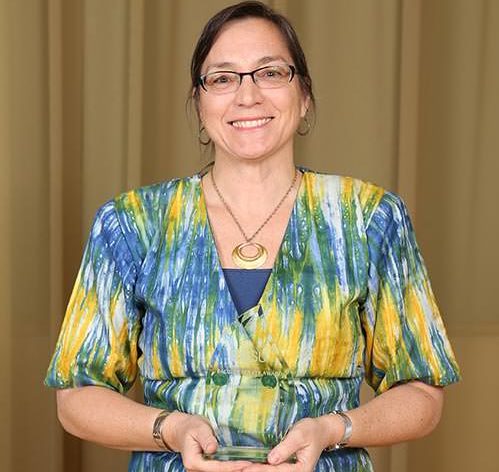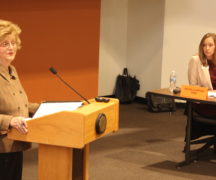By BGSU Office of Marketing & Communications
In her 20 years with BGSU, Dr. Rebecca Skinner Green, an associate professor of art history, has enhanced the University in myriad ways, from her leadership on the details of merit, tenure and promotion document revisions to the global, bringing scholars and artists from around the world to broaden the community’s horizons.
Skinner Green was recognized with the Faculty Senate Distinguished Service Award at the annual Faculty Excellence Awards held April 14. The award is given in recognition of outstanding, continuous service and to highlight the importance of dedicated faculty to the well-being of the University. Skinner Green received a $1,000 cash prize and a reserved parking spot for a year — a useful benefit for someone so involved not only with her own department but with numerous other areas across campus.
In her academic “home,” she served multiple times as chair of the art history division in the School of Art, from 2001-06, 2008-11 and again in fall of 2015.
“During all of my interactions as an art history faculty member working with Dr. Skinner Green as the chair, she has repeatedly proven herself to be an outstanding leader with exceptional good humor and collegiality throughout all of the ups and downs that one can expect to encounter in such a role,” Dr. Andrew Hershberger said. “Indeed, I regard Dr. Skinner Green as an excellent model for all faculty administrators in terms of how to run a division efficiently, effectively, and also with humanity.”
Since her earliest days as a faculty member, service has been her hallmark. “Even before she became a division chair, Dr. Skinner Green was nominated for and won the School of Art’s own Dorothy Uber Bryan Award for Exceptional Service in 1998,” Hershberger said.
She was the founder of the Art History Association and served as its adviser and has served on the Shanklin Graduate Research Award Committee, among numerous others.
“Her recent and longstanding service contributions to the School of Art include her leadership roles on the School’s Advisory Council; on the Curriculum Committee (within which she led the charge to revise around 80 courses over a number of years including the most recent BGP revisions and, before that, the entire art history curriculum — a historic event within the School and, according to former Associate Dean Frank Goza, within the college); and chairing the RPT Committee while merit, charter, promotion and tenure documents were all being revised, within a unit the size of the School of Art. There are very few faculty, I suspect, who can claim to have done more for their unit, and for their fellow faculty members in their unit, than Dr. Skinner Green,” Hershberger said.
But she also serves in other disciplines as well. “For the Africana Studies Program, Dr. Skinner Green has remained a selfless prime mover, especially for our annual student research conference, which she has elevated to a new level,” said Dr. Apollos Nwauwa, history faculty and director of the Africana Studies Program. “Despite her numerous engagements on campus, Dr. Skinner Green still devotes enormous time and effort to each committee/task as if it is the only one with which she is involved.”
The program presented her its own Distinguished Service Award in 2001.
Similarly, she has lent her support and her time to the Asian Studies Program, according to Director Akiko Jones. “Dr. Skinner Green has helped to promote our students’ awareness and appreciations of Asian arts and its roles in Asian cultures,” Jones said. “She has been a great committee member and I am extremely grateful for her contributions.”
A specialist in African art, Skinner Green has helped to create ties across disciplines and communities. “This is particularly true through her repeated organization of invited guest speakers, artists and scholars from across the U.S. and from across the globe, including individuals from Madagascar, Senegal, Ghana, Burkina Faso, the Netherlands, Nigeria, Trinidad — the list is long,” Hershberger said.
The classroom visits, conferences and performances both on and off campus in which they have taken part are a reflection of “Dr. Skinner Green’s indefatigable energy and enthusiasm for educational service that benefits her fortunate students and our entire University,” he said.
“I also know that she is the best colleague one could hope to work with, and that she always dedicates herself completely to the tasks at hand in all of her various service roles and duties within the Division of Art History, the School of Art, the College of Arts and Sciences, and in many other areas at BGSU and well beyond our campus through her service to professional organizations,” Hershberger said.





